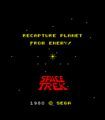Namcorules (talk | contribs) |
m (Update infobox) |
||
| Line 1: | Line 1: | ||
{{Header | {{Header Bar|game=Space Trek}} | ||
{{Game | |||
|completion=0 | |||
|image=Space Trek flyer.jpg | |||
|title=Space Trek | |title=Space Trek | ||
| | |japanese=スペーストレック | ||
|developer=[[Sega]] | |developer=[[Sega]] | ||
|publisher=[[Sega]] | |publisher=[[Sega]] | ||
| | |year=1980 | ||
| | |systems={{syslist|cade}} | ||
|genre | |genre=[[Shooter]] | ||
|modes=[[Single player]], [[Multiplayer]] | |modes=[[Single player]], [[Multiplayer]] | ||
}} | }} | ||
'''Space Trek''' is a vertical scrolling [[shooter]] arcade game that was released by [[Sega]] in [[1980]]; it runs on their Vic Dual hardware, and is one of the earliest games of its genre (predating [[Namco]]'s [[Xevious]] by two years). The player must use an eight-way joystick to direct a small white ship around the screen, with a button to make it fire shots at the enemies and a second button to activate its energy barrier - and when the energy barrier is activated, the ship will turn green, but it will turn red when that barrier is about to disappear. Also, when a UFO is killed, any planets (that you must avoid crashing into) on the screen will turn into enemies; the game's "warp" feature also allows for a quicker approach to an enemy base, and its scanner feature gives the player another chance to attack after all the enemies have been killed. Despite its name, it also has no connection with the old [[wp:Star Trek|Star Trek]] television series. | '''Space Trek''' is a vertical scrolling [[shooter]] arcade game that was released by [[Sega]] in [[1980]]; it runs on their Vic Dual hardware, and is one of the earliest games of its genre (predating [[Namco]]'s [[Xevious]] by two years). The player must use an eight-way joystick to direct a small white ship around the screen, with a button to make it fire shots at the enemies and a second button to activate its energy barrier - and when the energy barrier is activated, the ship will turn green, but it will turn red when that barrier is about to disappear. Also, when a UFO is killed, any planets (that you must avoid crashing into) on the screen will turn into enemies; the game's "warp" feature also allows for a quicker approach to an enemy base, and its scanner feature gives the player another chance to attack after all the enemies have been killed. Despite its name, it also has no connection with the old [[wp:Star Trek|Star Trek]] television series. | ||
| Line 21: | Line 21: | ||
[[Category:Sega]] | [[Category:Sega]] | ||
[[Category:Shooter]] | [[Category:Shooter]] | ||
[[Category:Single player]] | [[Category:Single player]] | ||
[[Category:Multiplayer]] | [[Category:Multiplayer]] | ||
[[Category:MAME]] | [[Category:MAME]] | ||
Latest revision as of 21:23, 14 February 2022

| Space Trek | |
|---|---|
| Developer(s) | Sega |
| Publisher(s) | Sega |
| Year released | 1980 |
| System(s) | Arcade |
| Japanese title | スペーストレック |
|---|---|
| Genre(s) | Shooter |
| Modes | Single player, Multiplayer |
Space Trek is a vertical scrolling shooter arcade game that was released by Sega in 1980; it runs on their Vic Dual hardware, and is one of the earliest games of its genre (predating Namco's Xevious by two years). The player must use an eight-way joystick to direct a small white ship around the screen, with a button to make it fire shots at the enemies and a second button to activate its energy barrier - and when the energy barrier is activated, the ship will turn green, but it will turn red when that barrier is about to disappear. Also, when a UFO is killed, any planets (that you must avoid crashing into) on the screen will turn into enemies; the game's "warp" feature also allows for a quicker approach to an enemy base, and its scanner feature gives the player another chance to attack after all the enemies have been killed. Despite its name, it also has no connection with the old Star Trek television series.
-
Title screen.
-
Cocktail arcade cabinet.
-
First round of the game.


